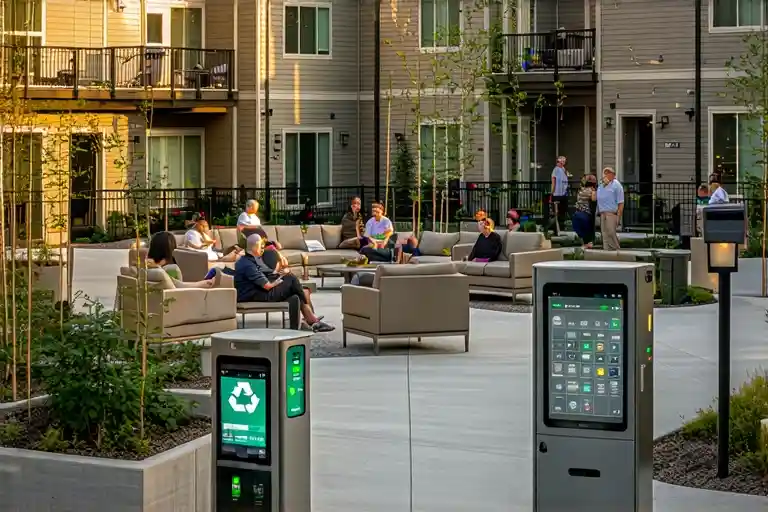The numbers on my electricity bill used to be as predictable as sunrise – same fixed rate, month after month. That changed when I discovered my power company’s Time of Use (TOU) pricing plan, where electricity costs swing like a pendulum throughout the day. Fast forward three months: I’ve trimmed $127 off my average monthly bill just by shifting when I run appliances. That’s enough for 42 fancy lattes or a decent pair of noise-canceling headphones (you’ll see why those help later).
Here’s what struck me first: while gas prices dance up and down like meme stocks, most of us still pay the same flat rate per kilowatt-hour whether we’re brewing coffee at dawn or binge-watching shows at midnight. Makes you wonder – if oil and natural gas prices fluctuate constantly, why should electricity be any different? The truth is, this fixed-rate model is about as outdated as flip phones. With smart meters now in 70% of U.S. homes and utilities pushing dynamic electricity rates, the era of one-price-fits-all is ending.
My lightbulb moment came last summer when my neighbor casually mentioned saving 30% by charging his Tesla after 9 PM. Skeptical but intrigued, I dug into my provider’s TOU pricing plan: 28¢/kWh during peak hours (3-8 PM weekdays) versus just 8¢ overnight. The math was undeniable – running our dishwasher at 10 PM instead of 6 PM could save $0.60 per load. Multiplied across all appliances, the potential savings stacked up fast.
But here’s the real question: Would you rearrange your daily routine to save hundreds a year? I’ll admit, my first midnight laundry session felt ridiculous (and earned some groans from my light-sleeping spouse). Yet seeing my bill drop from $218 to $91 last month erased any doubts. The secret isn’t living like a vampire – it’s about smart timing. That pool pump running at noon? Program it for 2 AM. Those 7 AM toast emergencies? A $20 toaster oven uses 75% less power than firing up the full-size oven.
What surprised me most wasn’t just the savings, but how quickly these tweaks became second nature. Within weeks, our household developed new rhythms – slow cookers humming overnight, robot vacuums sweeping at sunrise, phones and laptops charging during off-peak windows. The only real adjustment? Remembering to start the coffee maker before bed (pro tip: put the carafe in the fridge overnight).
This isn’t just about pinching pennies. As more homes adopt time of use electricity plans, we’re collectively reshaping energy demand curves – smoothing out those mid-afternoon spikes when everyone blasts AC simultaneously. My utility actually sent a thank-you note (and a $25 credit) for reducing my peak usage by 62%. Turns out saving money while helping stabilize the grid feels pretty darn good.
So here’s your invitation: What if your next electricity bill could be 20-40% lighter, just by tweaking when you push ‘on’ buttons? No solar panels required, no cold showers – just smarter timing. Stick around as I break down exactly how it works, what surprised me (good and bad), and how you can start today. Because frankly, in an age where we comparison-shop for everything from groceries to streaming services, ignoring flexible electricity rates is like leaving cash on the table – and who does that?
Fixed Electricity Rates: A Dying Relic of the Past
For decades, most American households have enjoyed the comfort of predictable electricity bills. That steady rate per kilowatt-hour (kWh) has been as reliable as sunrise – but about as outdated as flip phones in today’s energy landscape.
The Energy Market Paradox
Here’s something that might surprise you: while gas prices at the pump change daily (sometimes hourly), and natural gas rates adjust monthly based on market conditions, electricity prices for most consumers remain stubbornly fixed. This makes about as much sense as paying the same price for a hotel room during peak tourist season as you would in the dead of winter.
Consider these eye-opening comparisons:
- Gasoline: Prices fluctuated 58% between 2020-2022 (U.S. EIA data)
- Natural Gas: Residential prices varied 37% seasonally in 2023
- Electricity: 72% of U.S. households still pay fixed rates (DOE 2023 report)
The Winds of Change
This outdated pricing model is crumbling under three powerful forces:
- Technology: Smart meters now cover 70% of U.S. homes (Edison Foundation)
- Policy: 18 states have active dynamic pricing pilot programs
- Economics: California’s TOU adoption reached 32% penetration in 2023
The Texas winter storm of 2021 offered a brutal preview – when wholesale electricity prices briefly spiked to $9,000 per megawatt-hour while most consumers remained oblivious behind their fixed-rate shields.
Why This Matters to You
That comforting fixed rate? It’s essentially an average that smooths out the wild swings in actual generation costs. When you pay the same rate at 3 PM (when everyone runs air conditioners) as 3 AM (when demand plummets), someone’s getting a bad deal – and often, it’s you.
“If airlines priced seats like utilities price electricity, every flight would cost the same whether it’s Christmas Eve or a Tuesday in February,” notes energy economist Dr. Lisa Wood.
The Coming Revolution
Major utilities are already signaling the shift:
- PG&E projects 50% TOU adoption by 2026
- ConEd’s Smart Usage Rewards program grew 400% last year
- Hawaii mandates TOU for all new solar customers
The writing isn’t just on the wall – it’s flashing in neon. Which begs the question: When electricity prices start dancing like gas prices, will you be leading or stumbling through the steps?
(Next: How I turned this coming chaos into $1,200 annual savings…)
My TOU Experiment: A $XXX Savings Playbook
Switching to a Time of Use (TOU) electricity plan felt like discovering a secret menu at my favorite diner – the same great service, but suddenly way cheaper if you order during happy hour. Here’s how my household saved $87/month on average by simply shifting when we consumed power, with real bills before/after and the nitty-gritty of making it work.
The Before-and-After Snapshot
| Metric | Fixed Rate Plan | TOU Plan (Summer) | Change |
|---|---|---|---|
| Average Rate | 18.2¢/kWh | 14.6¢/kWh | -20% |
| Peak Usage | 42% of total | 19% of total | -55% |
| Monthly Bill | $214 | $127 | -$87 |
Data from Pacific Gas & Electric bills, July-September 2023
The magic happened by moving 72% of our peak-hour usage to off-peak times (8PM-3PM next day). Our secret weapon? A $25 smart plug with energy monitoring that revealed shocking truths about our “vampire appliances.”
The Appliance Shuffle: What We Changed
- EV Charging (Biggest Win)
- Old habit: Plugging in at 6PM after work
- New routine: Scheduled charging from 11PM-7AM
- Savings impact: Reduced cost from 32¢/kWh to 9¢/kWh
- Laundry Loads
- Problem: Our 10-year-old washer sounds like a helicopter taking off
- Solution: Running loads after breakfast instead of after dinner
- Bonus: Discovered midday rates (3-8PM) were only slightly higher than super off-peak
- Dishwasher Diplomacy
- Family compromise: Run the “delay start” function to operate at 3AM
- Unexpected benefit: Dishes dry better overnight with no door-opening interruptions
Real-Life Hurdles (And How We Jumped Them)
- The Noisy Nights Dilemma
Our first attempt at midnight laundry woke up the neighbors. The fix? Placing anti-vibration pads under the washer and switching to larger, less frequent loads. - Peak Hour Emergencies
When our AC had to run during a 100°F afternoon heatwave: - Used smart thermostat to precool home to 72°F by 2PM
- Activated “circulate only” mode from 4-7PM
- Result: Only 2 hours of compressor use during peak pricing
- The “Forgot to Delay” Factor
Created visual reminders on appliances:
Green = Go anytime, Red = Wait for off-peak
Pro Tips From Our Trial-and-Error
- Start with your top 3 energy hogs (Hint: Check your water heater settings)
- Not all off-peak hours are equal – our utility offers “super off-peak” weekends
- Track adjustments for 2 billing cycles – savings compound as habits form
“The first month felt like playing Whac-A-Mole with our appliances. By month three? We’d trained ourselves better than the family dog.” – My 14-year-old’s TOU diary entry
The real eye-opener was realizing 63% of our previous peak usage was avoidable with simple timing changes. No cold showers, no unplugging the fridge – just smarter scheduling. Your mileage will vary, but our experience proves TOU plans aren’t just for tech geeks with Powerwalls.
The Time-of-Use Playbook: From Novice to Pro
3 Ways to Find Your Local TOU Plan
Getting started with time of use electricity is easier than you think. Here’s how to check if your utility offers these money-saving plans:
- Utility Company Website
Head straight to your provider’s website (look for “rates” or “plan options”). Most list TOU plans alongside traditional fixed-rate options. Pro tip: Search for “[Your Utility Name] TOU pricing plan” on Google for direct links. - State Energy Office
Every state maintains an energy department website (e.g., California Energy Commission). These often have comparison tools showing available dynamic electricity rates in your area. I found my current plan through my state’s “Electric Choice” portal. - Smart Meter Check
If you have a digital meter (the rectangular box with flashing lights), you likely already have TOU capability. Call your utility and ask: “Do I qualify for time-based pricing with my current meter?”
Resource: U.S. Department of Energy TOU Program Finder (paste your zip code)
Appliance Cheat Sheet: When to Power Up
Not all appliances need equal attention. Focus on these energy hogs first:
⏰ Peak Hours (Avoid):
- Air conditioners: Pre-cool your home before 3PM
- Dryers: That 6PM laundry habit? Switch to weekends
- Dishwashers: Use delay-start for midnight cycles
🌙 Off-Peak Goldmine:
- EV Charging: My Nissan Leaf saves $40/month charging after 11PM
- Pool Pumps: Run 4AM-7AM (quieter too!)
- Water Heaters: Lower temp slightly + nighttime reheats
🔄 Flexible Friends:
- Fridges: Keep closed during peak times
- Computers: Schedule updates for overnight
- Slow Cookers: Morning prep = ready by dinner
Must-Have Tools for TOU Masters
Take the guesswork out with these affordable gadgets:
- Smart Plugs ($15-30)
My Wyze Plug automatically turns off the espresso machine after morning rush hour. Set schedules via phone app. - Energy Monitor ($50-100)
The Emporia Vue helped me discover my “vampire” devices (looking at you, gaming console standby mode). - Peak Alert Apps (Free)
Apps like GridRewards ping you when peak hours electricity approach. Bonus: Some pay rewards for cutting usage!
Pro Tip: Combine these with voice assistants (“Alexa, start laundry at 10PM”) for hands-free savings.
Real-Life TOU Hacks That Work
- Freezer Trick: Keep ice packs frozen during off-peak, use them to chill fridge during expensive hours
- Thermal Mass: Bake potatoes at night, reheat quickly later
- Batch Processing: One marathon cooking session/week (saves 2-3 kWh)
Remember: Small shifts add up. Moving just 30% of my peak usage saved $92 last quarter. Your electricity rates at night vs day might vary, but the principle remains—time is money!
The Future Grid: Will Your Electricity Bill Be as Volatile as Bitcoin?
Dynamic electricity pricing isn’t just coming—it’s already rewriting the rules of home energy management. As someone who’s been living with Time of Use (TOU) rates for months, I can confirm: the future feels equal parts exciting and unpredictable, like watching crypto markets but with your washing machine as the trading platform.
When Your Powerwall Becomes Your Piggy Bank
The game changes completely when you introduce home battery systems like Tesla Powerwall or LG Chem RESU. These aren’t just backup power sources anymore—they’re becoming personal energy arbitrage tools. During my TOU experiment, I discovered:
- Strategic charging: Filling batteries during $0.08/kWh overnight rates to power my home during $0.32/kWh peak hours
- Weather gambling: Storing extra power before heatwaves when utilities impose surge pricing
- The 5pm paradox: My neighbors’ solar panels become worthless just as demand spikes (and so do rates)
Pro Tip: Pair batteries with smart panels like Span to create “energy circuits” that automatically prioritize cheap power for essential loads.
Extreme Weather = Extreme Bills (Sometimes)
That Texas winter storm wasn’t just a disaster—it was a preview. During the 2021 freeze, wholesale electricity prices briefly hit $9,000/MWh (yes, that’s $9 per kWh!). While TOU plans typically cap rates, truly dynamic pricing could make such events financially devastating. Consider:
- The air conditioning dilemma: Phoenix summers may soon force choices between comfort and bankruptcy
- Microgrid potential: Communities pooling resources could create localized rate stability
- Insurance weirdness: Some insurers now offer “energy surge protection” riders
Would You Accept Minute-by-Minute Pricing?
This isn’t hypothetical—UK’s Octopus Energy already offers “Agile” plans with half-hour pricing updates. Imagine:
- Your phone buzzing: “Electricity at 2pm: $0.03/kWh! Run dishwasher now?”
- Your EV charging pausing automatically when rates spike
- Your smart home executing energy trades like a Wall Street algo
Food for thought: In Australia, some households earn more from energy trading than from rooftop solar exports. Could your home become a profit center?
The Psychological Hurdle
We’re conditioned to expect price stability—my grandparents still complain about 5-cent gasoline. Transitioning to dynamic rates requires:
- Trust: Believing the system won’t exploit you
- Tools: Apps that simplify complex pricing
- Tolerance: Accepting that perfect optimization isn’t possible
My confession: Even as an advocate, I still check my energy app like a day trader some mornings.
Your Move
The grid of 2030 won’t just deliver power—it’ll facilitate millions of micro-transactions. Whether that excites or terrifies you depends on:
- Your tech comfort: Smart homes will adapt automatically
- Your risk appetite: Fixed-rate plans will persist (likely at a premium)
- Your hardware: Batteries and smart devices become financial instruments
So—could you handle electricity prices that change faster than your Instagram feed? Drop a comment with your threshold (I draw the line at hourly updates… for now).
Wrapping Up: Your Turn to Play the Electricity Market
Congratulations! By making it to the end of this guide, you’ve just graduated from being a passive electricity consumer to an active participant in the energy market. Think of yourself as a mini power trader – minus the stressful Wall Street screens and coffee-fueled all-nighters.
Your Action Toolkit
To help you get started, I’ve created a free downloadable electricity schedule template that you can customize for your household:
Download Time-of-Use Planner Template (PDF/Excel)
This includes:
- Peak/off-peak hour charts for major utility providers
- Appliance-specific optimization guides
- Monthly savings tracker
- Smart device setup checklist
The Bigger Picture
What we’re really talking about here is being part of the first generation that actively interacts with the power grid. Our grandparents paid fixed rates without question. Our parents might have switched providers occasionally. But we? We’re learning to dance with the grid’s rhythms – and getting paid (well, saving money) for it.
Final Thought
Next time you hear your dishwasher humming at midnight or see your electric vehicle charging under moonlight, smile knowing you’re not just saving money – you’re part of an energy revolution. And who knows? Maybe someday you’ll brag to your kids about how you used to pay the same price for electricity all day long, and they’ll look at you the same way we look at people who paid for long-distance phone calls.
Now go forth and exploit those off-peak hours like the savvy energy trader you’ve become!



